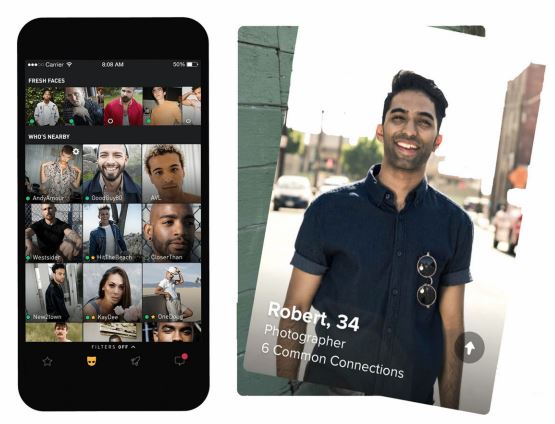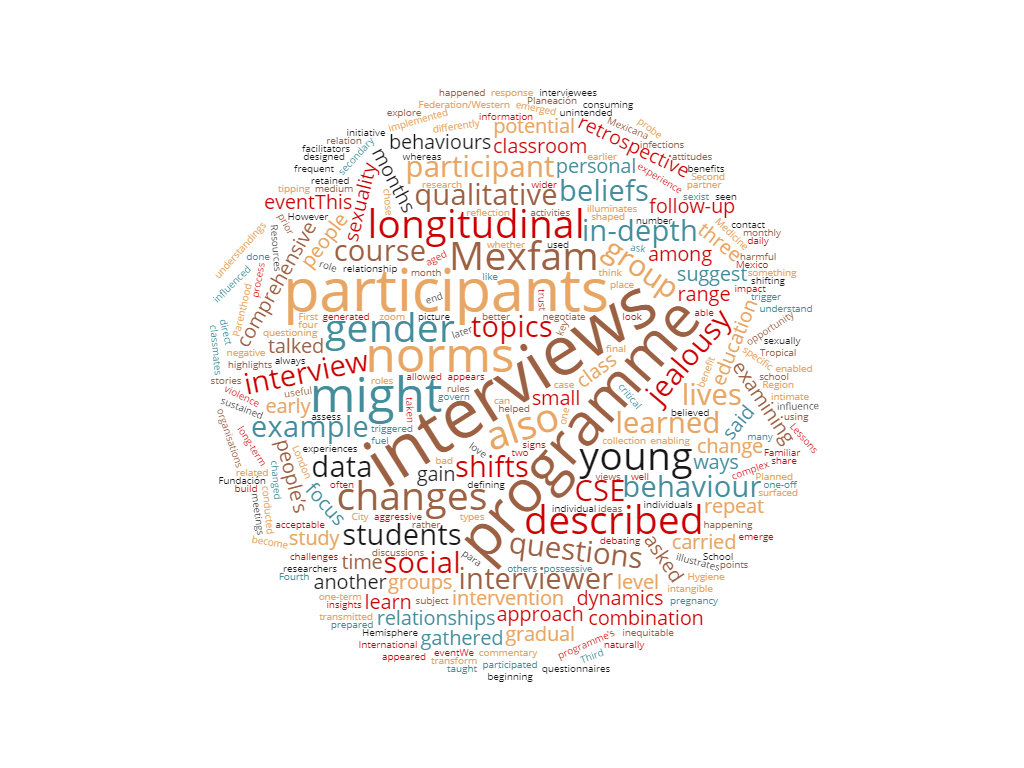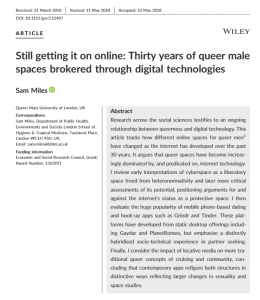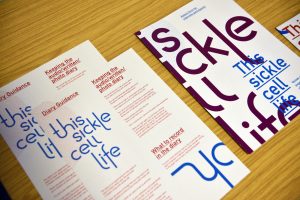How do researchers go about interviewing people about sex and sexualities? To what extent do we – or should we – share our own experiences? And what kind of ‘spaces’ do these highly personal conversations fit into?

DEPTH researcher Dr Sam Miles was invited by the academic journal Area to write a blog for their outreach website Geography Directions, based on his recent article ‘“I’ve never told anyone this before”: Co‐constructing intimacy in sex and sexualities research’. In the blog, Sam explores the ethics of fieldwork in sex and sexualities research. Have a read…
The (in)famous male-male dating and hook-up app Grindr recently celebrated its 10th birthday. To mark the anniversary, a whole range of articles have cropped up variously celebrating and lamenting Grindr’s influence across the world (by which I mean literally across the world – it counts nearly 4 million active users across 234 different countries (Grindr, 2019)). What makes this generation of mobile phone matchmakers different from the online platforms that went before them, for example Gaydar, match.com, Yahoo chatrooms? Apps such as Grindr are GPS-enabled, which enables users to ‘rank’ other users of the app by proximity, ensuring that potential matches can be discovered and introduced in real-time across physical space.
Reflecting on Grindr’s first decade, The BBC identifies a ‘rocky relationship’, whilst VICE magazine explores Grindr’s relationship with identity fraud and drug-based ‘chemsex’; meanwhile, Gay Times reports that 56% of Grindr users believe they can find true love on the app. Whatever your opinion on it – and there are many – there is no doubt that this mobile phone matchmaker, along with its competitors Hornet, Scruff & Jack’d, has had a profound impact on gay and bisexual communities. These apps have also opened up new avenues for men seeking sex with men (MSM) who for whatever reason – familial, cultural, or religious – do not identify as gay or bisexual.

The bigger question raised by these recent articles seems to be: how do dating and hook-up apps impact on same-sex and queer relationships today? This question cannot be answered by quantitative usage data alone. After all, we know that high usage does not necessarily mean high popularity. We need to explore peoples’ real life experiences in order to more fully understand the impact of dating and hook-up apps on same-sex and queer relationships.
I decided that the best way to get a detailed understanding of how these apps influence sexual and social behaviours would be to interview users about their experiences online, offline, and in the ‘hybrid’ space bridging the two, where virtual introductions result in real-life encounters. My doctoral research revealed some important findings: (1) that dating and hook-up apps play a significant role in how men now meet other men, especially within wider debates about the ‘death of the gay bar’, and (2) that the relationship between mobile phone dating app users and the people they meet can be awkward, with social cues yet to catch up to the sophistication of the technologies in use.
The sensitive nature of the research topic meant that there was an array of ethical and practical challenges for me to grapple with during my doctoral fieldwork. In my recent Area paper, I reflect on some of these challenges and explore how researchers and participants can work together to create a meaningful space that not only enables data collection, but facilitates honest and valuable conversation. I consider what the researcher’s responsibility should be for a participant’s safety in this discursive space. I also reflect on how ‘involved’ I should be as a researcher. I’m a person, not a robot, and several decades of feminist research has already explored the strengths and issues bound up in bringing ‘yourself’ into the research field (for example, see Bain & Nash (2006) and Smith (2016)). But the opposite extreme of the objective, positivist robot researcher is the inappropriately involved one, a role which would be both institutionally unethical and personally unacceptable. I therefore identified my own boundaries as well as the participants’s boundaries. The result was a co-constructed discursive space that we worked together to construct, perhaps surprisingly, in totally public venues and in one-off, hour-long interviews rather than more private or longer-term meetings. These were not ‘intimate’ spaces in a traditional sense, but nevertheless the space-within-a-space that we constructed invited app users to speak about highly personal experiences, some for the first time ever.
I also make the case for the using public places for staging sensitive conversations. The assumption that private matters cannot be discussed in public requires a rethink. Public spaces like libraries or cafes enfold within them more private spaces – not just actual booths or nooks, although these can contribute – but I’m thinking here about more conceptual spaces. These are built simply via one-to-one, in-person conversation in a space where a hubbub of background talking, or the hiss of coffee machines brewing, provides a backdrop to conversation that can be very productive.
Finally, when it comes to dating and hook-up apps in particular, I suggest that people are particularly keen to share their views because the social norms of dating app use are so complex and still so poorly understood. For lots of people online dating remains taboo. In this context, the chance to share their thoughts, feelings and experiences when it came to the digitally-introduced, physically-involved relationships these platforms offer may have been liberating.
Love dating apps or hate them (or both), what I hope the article communicates is that we need to talk more with users about the ways in which technologies impact on our personal lives, in order to think about the social codes developing from their use that will inform a whole range of wider contexts.
What do you think? Let us know by commenting below…
References:
Bain, A., & Nash, C. (2006) Undressing the researcher: Feminism, embodiment and sexuality at a queer bathhouse event. Area, 38, 99–106. https://rgs-ibg.onlinelibrary.wiley.com/doi/pdf/10.1111/j.1475-4762.2006.00663.x
Damshenas, S. (2019) 56% of Grindr users believe they can find love on the app, study finds. Gay Times. Retrieved from: https://www.gaytimes.co.uk/community/119691/56-of-grindr-users-believe-they-can-find-love-on-the-app-study-finds/
Fox, L. (2019) 10 years of Grindr: A rocky relationship. BBC News. Retrieved from: https://www.bbc.co.uk/news/technology-47668951
Grindr. (2019) Grindr.com. Retrieved from: https://www.grindr.com/
Miles, S. (2017) Sex in the digital city: location-based dating apps and queer urban life. Gender, Place & Culture, 24, 1595-1610: https://www.tandfonline.com/doi/abs/10.1080/0966369X.2017.1340874?tab=permissions&scroll=top
Miles, S. (2018) Still getting it on online: Thirty years of queer male spaces brokered through digital technologies. Geography Compass. e12407. ISSN 1749-8198 DOI: https://doi.org/10.1111/gec3.12407
Miles, S. (2019) “I’ve never told anyone this before”: Co‐constructing intimacy in sex and sexualities research. AREA. https://rgs-ibg.onlinelibrary.wiley.com/doi/full/10.1111/area.12550
Smith, S. (2016) Intimacy and angst in the field. Gender, Place & Culture, 23, 134–146.
Staples, L. (2019) Grindr Users Talk Highs and Lows After Ten Years of the App. VICE Magazine. Retrieved from: https://www.vice.com/en_us/article/59x83d/grindr-users-talks-highs-and-lows-after-ten-years-of-the-app-1




 Tip: In outlook, emails can easily be converted into appointments or meetings. Using this means you have relevant details in your time block ‘appointment’ when you work on the task (assuming you are time blocking using Outlook calendar), rather than having to go back and search for them.
Tip: In outlook, emails can easily be converted into appointments or meetings. Using this means you have relevant details in your time block ‘appointment’ when you work on the task (assuming you are time blocking using Outlook calendar), rather than having to go back and search for them.


 Trying to better understand the relationship between sex an
Trying to better understand the relationship between sex an
 Beyond MSM populations specifically, this idea of technology redefining community, whether for better or worse (or indeed both!) is crucial to how we understand how technology mediates human behaviour. In a public health context, technology needs to be harnessed in ways which are alert to local conditions, whether that is in terms of unequal access to technology, or an affinity (or restriction) to certain kinds of communication device. At the same time, the widespread adoption of mobile phone technology – 5 billion people
Beyond MSM populations specifically, this idea of technology redefining community, whether for better or worse (or indeed both!) is crucial to how we understand how technology mediates human behaviour. In a public health context, technology needs to be harnessed in ways which are alert to local conditions, whether that is in terms of unequal access to technology, or an affinity (or restriction) to certain kinds of communication device. At the same time, the widespread adoption of mobile phone technology – 5 billion people 

 The panel plenary, with a focus on inequalities, was fascinating. The keynote papers from Professor
The panel plenary, with a focus on inequalities, was fascinating. The keynote papers from Professor 

 Hello re
Hello re